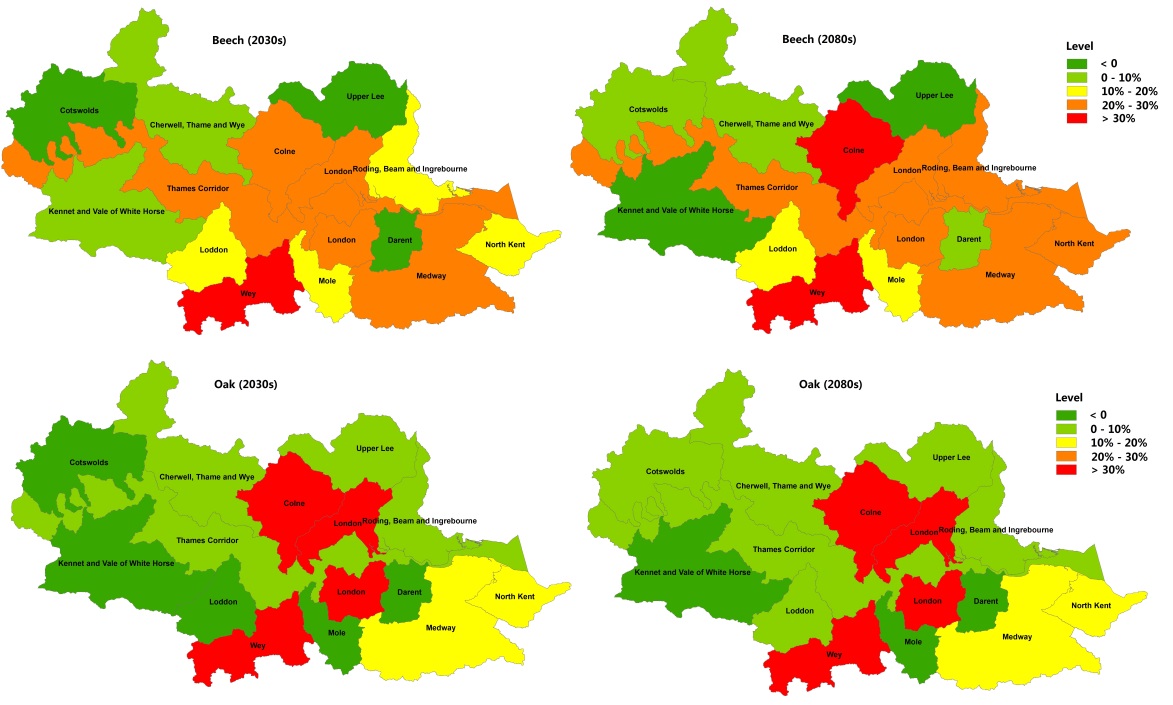Key science findings
- Droughts can alter the processes that govern terrestrial ecosystems, leading to changes in their species composition, structure and functioning, their interactions and benefits they provide to people.
- Ecosystems in the south and east of England and Wales are more likely to be altered by climate change than those elsewhere in Great Britain.
- In woodlands, beech and oak appear to be more susceptible drought than other tree species.
Introduction
Climate change is already affecting habitats and their species in several ways and future changes in temperature and water availability are likely to lead to further changes in the distribution of many species and thus in habitat composition and functioning . Both water scarcity and drought could also result in changes to the ecosystem services provided by the ecosystems and their species.
In Marius we focused on selected wetland, grassland and woodland ecosystems. Woodlands are very important for biodiversity, carbon storage, water regulation and watershed protection. Recent literature has reported drought-induced mortality and dieback of forests in different regions across the world. In Great Britain, the potential impacts of drought on tree species and woodlands are not well understood. In Marius, therefore, we have analysed the temporal and spatial patterns of the potential impacts of and vulnerability to drought for important British forest species.
Research methods
For each of the wetland, grassland and woodland ecosystems, we selected three categories of species: dominant, functional and/or sensitive to climate change and of conservation importance. Then, using databases of species’ distribution or published maps, which we digitised, we applied an ensemble of species distribution models (BIOMOD) and also an artificial neural network model (SPECIES) to characterise the relationship between each distribution and baseline climate. We then applied two different (Low and High) UKCP09 emissions scenarios for the 2020s, 2050s and 2080s and five spatially consistent projections, as well as the Marius future events dataset, to these relationships in order to project how the suitable climate space for the species might change. The potential impacts on the ecosystems were inferred by examining the changes in suitable climate space for its dominant and characteristic species.
For the analysis of tree species’ response to drought, we applied a version of the LPJ-GUESS (a process-based dynamic vegetation) model parameterized for 18 European tree species and/or plant functional types to simulate vegetation dynamics across Great Britain and the Thames basinfor the period 1961 to 2011. In LPJ-GUESS, tree mortality was considered to be partly a function of water stress leading to reduced growth-efficiency and increasing age. The Z-score of the simulated mortality was used to compare the mortality severity in any year ignoring any long-term trend for each species and different time periods. Thus, a positive Z-score above a specified threshold indicated a potential impact of drought of concern. Changes in suitable climate space for MG 4 Alopecurus pratensis–Sanguisorba officinalis Lowland hay meadows species under different UKCP09 scenarios.
This grassland type is currently found almost entirely within England, with only a few sites in the east of Wales. The species that characterise it are projected to progressively lose suitable climate space in southern, eastern and central England and in Wales (Fig X). One species, great burnet (Sanguisorba officinalis) is modelled to lose all suitable climate space in Great Britain under one projection and bird’s-foot trefoil (Lotus corniculatus) to lose none. This suggests that in the southern half of England there could be changes in the composition of this habitat.
There are important concentrations of lowland meadows in the Thames Basin, but by the 2050s some of it is likely to become climatically unsuitable for these species. Under the high emissions scenario, all suitable climate space for most of them is projected to be lost by the 2050s, leading to a potential loss of this habitat which is important for conservation.
Changes in suitable climate space for MG 4 Alopecurus pratensis–Sanguisorba officinalis Lowland hay meadows species under different UKCP09 scenarios.
This grassland type is currently found almost entirely within England, with only a few sites in the east of Wales. The species that characterise it are projected to progressively lose suitable climate space in southern, eastern and central England and in Wales (Fig 1). One species, great burnet (Sanguisorba officinalis) is modelled to lose all suitable climate space in Great Britain under one projection and bird’s-foot trefoil (Lotus corniculatus) to lose none. This suggests that in the southern half of England there could be changes in the composition of this habitat.
There are important concentrations of lowland meadows in the Thames Basin, but by the 2050s some of it is likely to become climatically unsuitable for these species. Under the high emissions scenario, all suitable climate space for most of them what_are_droughts/is projected to be lost by the 2050s, leading to a potential loss of this habitat which is important for conservation.

The spatial pattern of drought-induced tree mortality levels across the Thames Basin in the 2030s and 2080s (Figure 2) shows that generally, beech is more susceptible to drought than oak especially in the southeast Thames Basin. The level of drought impact on beech is slightly increased in the 2080s, whereas the similar trend is not evident for oak. Amongst the sub-catchments, the Wey and Colne appear to be particularly affected under almost all climate scenarios, followed by London for oak. The western sub-catchments (e.g. Kennet and Cotswolds) are less affected.

Further information
Visit the Droughts, people and environment dashboard here


